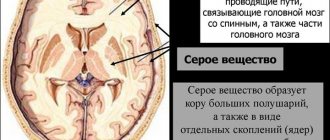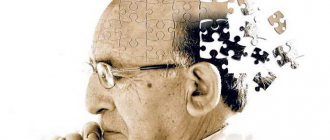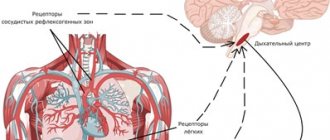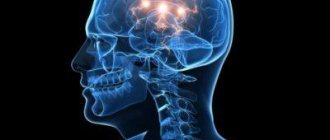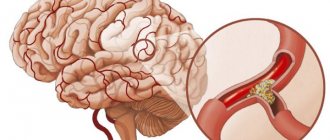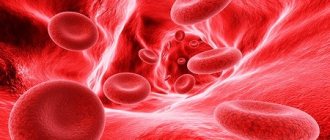- July 13, 2018
- Neurology
- Voloshchuk Natalya
There is not a single organ in the human body that functions without oxygen and nutrients carried by the blood. This is especially true for the human heart and brain, since the metabolic processes that occur in them proceed quite quickly. But it happens that oxygen delivery is disrupted, since small vessels poorly supply the organs and tissues of the body with it. This anomaly can appear in any organ, but the most dangerous is cerebral microangiopathy; we will discuss what it is below.
Description
Brain microangiopathy is a disease in which there is damage to small vessels and capillaries that are responsible for metabolic processes. In this case, impaired blood circulation in the brain is observed. In most cases, this pathology develops against the background of other ailments, such as diabetes, tumors and infections. Insufficient blood circulation in the brain, which is chronic, is characterized by a lack of glucose and oxygen for a long period of time, which leads to pathology in the structure and activity of small vessels in the brain, resulting in damage to the white matter. Doctors refer to microangiopathy as a condition that is characterized by dilation and thickening of capillary walls. The disease is considered serious and can be fatal.
General characteristics of the disease
Macroangiopathy is a disease that affects large vessels located anywhere in the body. Over time, the vascular walls are destroyed, their functioning fails, which inevitably affects the functioning of the internal organs.
As the pathology progresses, irreversible consequences arise. The tissues that feed the damaged vessel begin to die. This leads to the development of severe diseases and can even cause death.
Depletion of the walls of large vessels and their further destruction is called macroangiopathy
Causes
Microangiopathy is usually observed in the presence of other pathologies, for example, oncology, diabetes, hemolysis or infections. In this case, the blood vessels of the brain suffer. It develops due to the following four reasons:
- The presence of thrombosis, as a result of which normal blood flow is disrupted due to the appearance of blood clots in the vessels.
- Formation of necrosis of cells and tissues.
- The appearance of hyalinosis, which is the accumulation of hyaline in the body.
- The development of fibrinoid swelling, which leads to the destruction of connective tissue.
Quite often, cerebral microangiopathy (we know what it is) is a complication of diabetes mellitus, which a person has had for a very long period. Damage to the capillaries of the kidneys, nerves and eyes occurs here. In this case, thickening of the capillary membranes is observed in the vessels, blood clots form in the microcirculation and venules, hyalinosis, and capillary aneurysms.
Risk factors
Cerebral circulation, which leads to microangiopathy, is not rapidly impaired. This is preceded by a long process, which is associated with the following factors:
- genetic pathologies that cause disturbances in vascular tone;
- diseases associated with blood clotting;
- infections and injuries;
- smoking and drinking alcohol;
- age over fifty years;
- endocrine diseases and diseases of the heart and blood vessels, hypertension;
- hazardous working conditions and hard work.
Forms
Depending on many symptoms, cerebral microangiopathy is divided into four forms:
- Cerebral microangiopathy of the brain - develops in older people and is associated with impaired protein deposition. This disease is not diagnosed and practically cannot be treated with medication.
- Lenticulostriate microangiopathy is observed in children, so the child must be constantly monitored over time. There is an opinion that this form of the disease is a special type of blood supply, and therefore does not require treatment unless mental and physical abnormalities are observed.
- Diabetic angiopathy is characteristic of people with diabetes. This disease requires treatment of the underlying disease, as it is constantly progressing.
- Hypertensive vascular microangiopathy of the brain is observed in people with arterial hypertension, so it is recommended to prevent changes in blood pressure.
Depending on the form of the disease, the pathology can lead to various negative consequences, so it is important to seek help when the first symptoms appear.
Diabetic macroangiopathy
Diabetic macroangiopathy develops as one of the late consequences of type 1 diabetes mellitus and is accompanied by atherosclerosis of the cerebral, coronary, renal arteries, and aorta, which is manifested by cardialgia, brain disorder and neurological symptoms, secondary renal hypertension, trophic ulcers and gangrene of the legs.
The increase in diabetic macroangiopathy determines the prognosis of the disease as a whole, because the likelihood of stroke and cardiac ischemia increases several times with angiopathy, and gangrene of the legs increases up to 20 times.
Atherosclerotic damage to the arteries in diabetic patients has many features that distinguish it from isolated atherosclerosis. Among them:
angiopathy in diabetes using the example of legs
- Early onset of vascular lesions and a high rate of progression - diabetic angiopathy develops in younger people and more quickly leads to vascular occlusion with a total disorder of blood flow;
- Systemic damage to arterial vessels involving many organs - generalized atherosclerosis of the cardiac, cerebral, carotid, renal, iliac arteries, aorta;
- The combination of macroangiopathy with damage to the microvasculature and neuropathy, which significantly aggravates trophic disorders and contributes to heart attacks and gangrene.
The pathogenesis of diabetic macroangiopathy is based on structural changes in the layers of the arterial walls. Due to damage by their circulating metabolites, against the background of hyperglycemia, a change in the internal lining of blood vessels occurs, destruction of muscle and elastic fibers with infiltration of the artery wall with fat-protein complexes.
Symptoms
Microangiopathy of the brain (what it is is described above) has many signs of manifestation. The patient has a memory disorder, weakness and headache for no reason, and clouding of consciousness occurs. This is caused by impaired blood flow in the capillaries and vessels of the brain. Lipid oxidation processes are activated in the vessels, free radicals are formed, which contribute to the destruction of brain cells.
Symptoms develop very slowly, so a person almost always reacts to the disease with a delay. First of all, impaired cerebral blood flow leads to weakness and fatigue. Then headaches appear that do not go away after taking medications. Then sleep disturbance occurs, absent-mindedness and inattention appear, thinking becomes rigid. Patients experience astheno-neurotic syndrome, characterized by irritability and a tendency to depression. Then focal symptoms appear: the person has an unsteady gait, a disorder of movement coordination and convergence, different pupil sizes, etc.
Signs of microangiopathy include blurred vision, nose and stomach bleeding, pain when walking, discomfort in the legs, dry and flaky skin of the feet, and the presence of blood in the urine. The greatest danger is internal bleeding between the meninges or into the white matter.
Diagnostics
Microangiopathy of the brain, what it is, we already know, is diagnosed using magnetic nuclear resonance, which makes it possible to study brain tissue and the vascular network. With the disease, hypoplasia of the arteries, foci of silent infarctions, microscopic hemorrhages, and cerebral hypoperfusion will be visible. Modern doctors call microangiopathy disculatory encephalopathy. MRI and Doppler ultrasound are often used for diagnosis, which makes it possible to determine abnormalities in the vessels. An additional research method is a blood test, radiography and CT.
Drug and surgical treatment of vascular microangiopathy
Treatment of brain pathology microangiopathy occurs in a comprehensive manner, using a low-cholesterol diet, as well as a diet to reduce blood glucose, as well as using medications of various pharmacological groups:
| pharmacological group | names of drugs |
| antihypoxants to prevent hypoxia of brain cells | Emoxipin |
| Statins | drug Lovastatin |
| febrate group | Fenofibrate |
| nootropic medications | · Nootropil; |
| · Piracetam; | |
| · Pantogam | |
| antihypertensive drugs | · Tenoric; |
| · Kapoten | |
| means to improve microcirculation | · Pentoxifylline; |
| Xanthinol | |
| group of angioprotector drugs | · Dicynone; |
| · Complamin | |
| medicinal group of antioxidants | · Selenium; |
| · vitamin E; | |
| B vitamins | |
| group of antiplatelet drugs | · Cardiomagnyl; |
| · Chimes; | |
| · Trental | |
| coenzymes for diabetes | · Flavinate; |
| Cocarboxylase |
In addition to medication treatment, physiotherapy is used:
- Plasmapheresis method;
- Mud treatment;
- Electric wave stimulation;
- Thermal heating;
- Balneotherapy technique;
- Massotherapy;
- Acupuncture to restore reflexes.
To restore the lumen in the vessels, surgical intervention is used using cryosurgery or laser coagulation.
Treatment
Microangiopathy of the brain is treated comprehensively. First of all, medications are prescribed that normalize blood pressure and also eliminate signs of lack of oxygen in the brain tissue. Lipid levels are corrected, and statins, fibrates, bile acids, etc. are prescribed. To better supply the brain with oxygen, doctors prescribe nootropic drugs, as well as nicotinic acid. Surgical intervention for this disease is carried out in rare cases, only when it is not possible to restore the vessels with medication, and the circulatory deficiency cannot be compensated by lateral blood flow pathways. Along with drug treatment, patients are prescribed massage and a swimming pool, this helps improve their condition. But the foci of gliosis do not disappear; over time, their number increases.
Preventive actions
The following preventive measures are recommended for patients:
- Make more frequent visits to the doctor and carry out procedures.
- Follow dietary recommendations.
- Don't smoke, don't drink.
- Regularly measure your blood pressure, do a blood test, and check your glucose levels.
- Exercise. Spend time outdoors as often as possible.
Gradually worsening symptoms of the disease influence changes in the patient’s lifestyle. Destroyed brain tissue cannot be restored.
Forecast
The prognosis worsens if the patient has hypertension. In this case, symptoms appear very quickly as the disease progresses. In older people, cerebral vessels have weak tone, so the disease progresses even faster. In children, the prognosis can be positive if there are no deviations in mental or physical development.
Often, cerebral microangiopathy leads to encephalopathy of varying severity or to stroke. If you do not begin to treat the disease in the first stages, the patient’s condition will worsen, leading to disability and then death. The disease cannot be completely cured. Foci of gliosis in the brain cannot be completely eliminated, but their formation can be slowed down.
Possible consequences
Capillary pathology belongs to the list of serious diseases and requires the use of complex therapy. If the necessary therapy is not used, the patient's condition worsens. Results of poor quality treatment: disability, death.
Delayed contact with a specialist leads to the following results: stroke, heart attack, blindness, kidney problems.
Preliminary diagnosis of the disorder, the site of inflammation, and vascular deformation can reduce the consequences of the disease. It is impossible to completely eliminate the symptoms of the disease ; adequate treatment makes it possible to slow down the development of the disease and avoid possible complications.
